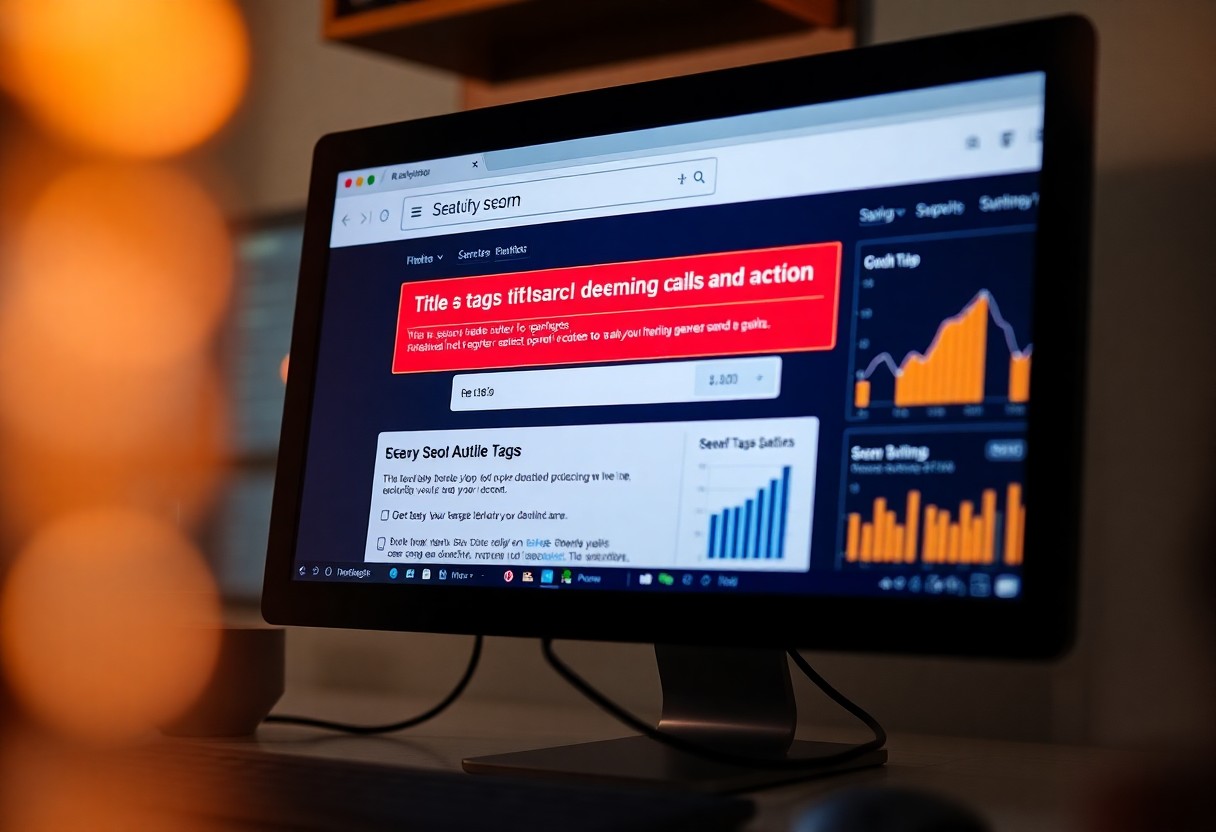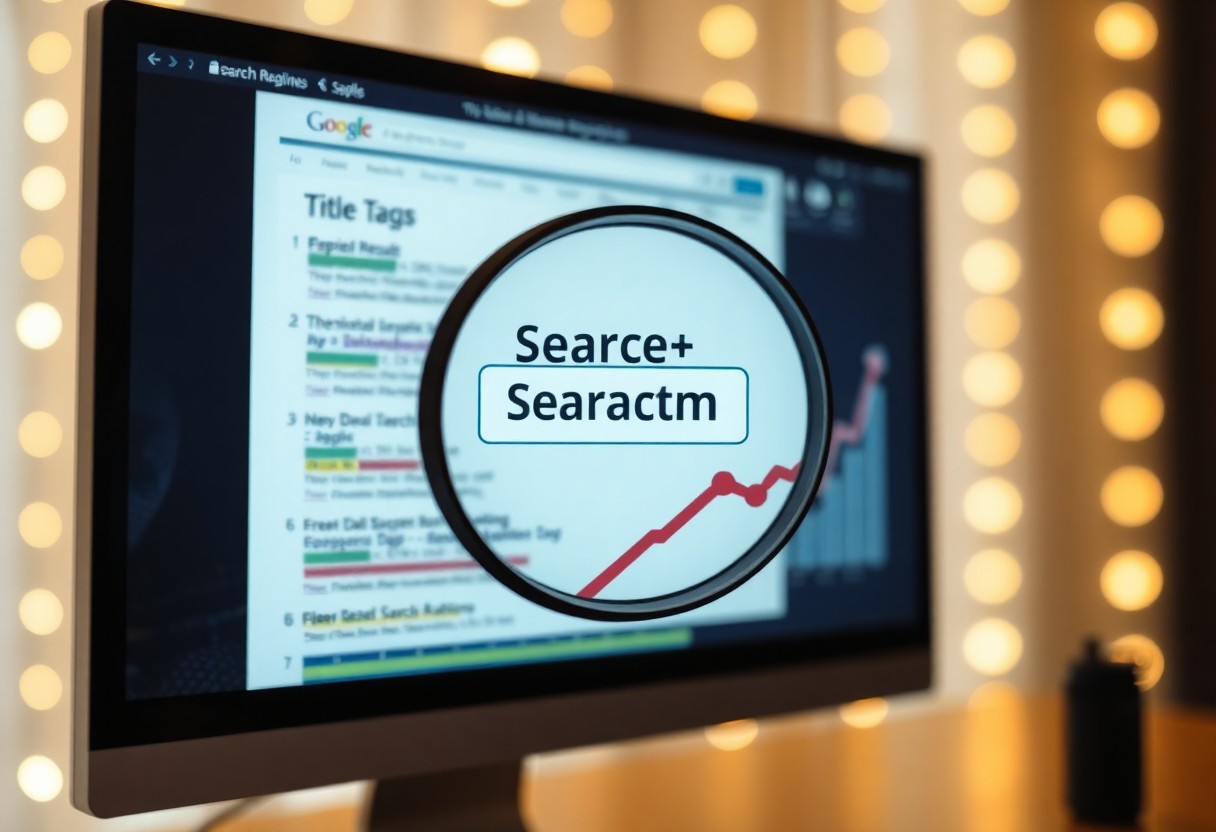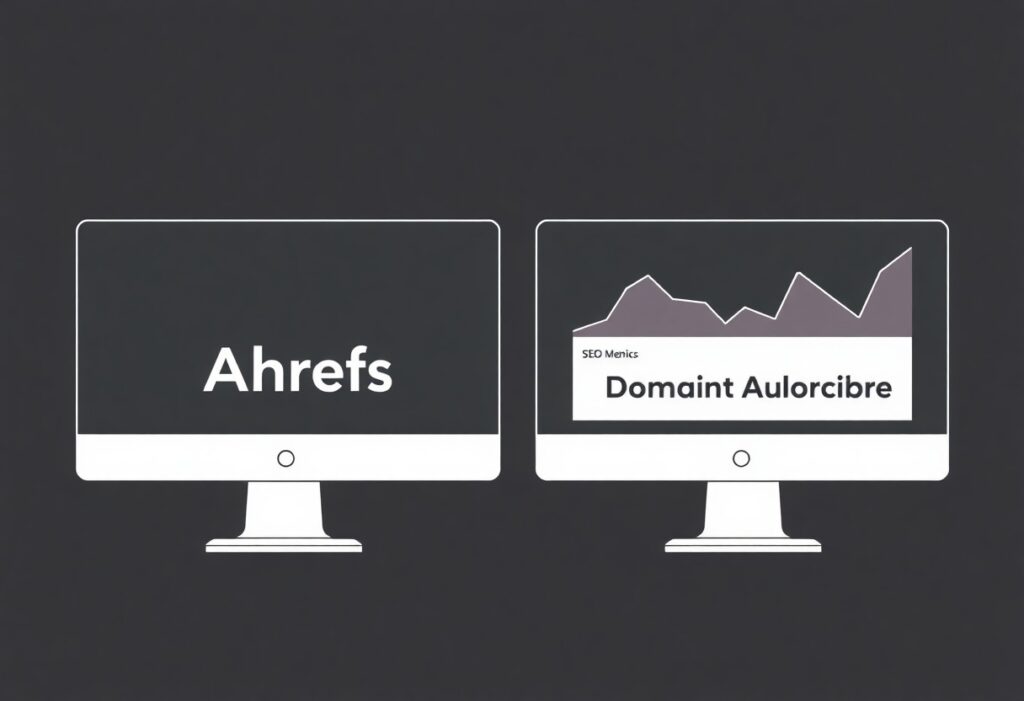With Calls-to-Action (CTA) in title tags, you may wonder if they truly enhance your search rankings. As a business owner, understanding this can significantly impact your visibility. Many people believe that including a CTA in your title can drive higher click-through rates. However, it’s vital to analyze how this strategy correlates with SEO performance. In this post, you’ll discover whether incorporating CTAs can make a difference for your ranking on search engines such as Google. Let’s dive in and explore how Rank Authority can help you elevate your website’s presence using effective CTAs.
Understanding Title Tags: Calls-to-Action (CTA)
The Calls-to-Action (CTA) in title tags play an vital role in attracting user attention and improving click-through rates. Title tags are HTML elements that specify the title of a web page, serving as a primary indicator of your content’s relevance to search engines. By effectively crafting your title tags, you can drive more organic traffic to your site and enhance the overall user experience. Keeping your target audience in mind while using CTAs can help you convey the right message and lead users to take the desired action.
Importance of Title Tags in SEO
At the core of your SEO strategy, title tags significantly impact your site’s visibility and search rankings. Each page’s title tag informs search engines and users what to expect from the content. Utilizing Calls-to-Action (CTA) within title tags not only makes your titles more enticing but can also improve your page’s click-through rate. Consequently, improving CTR can lead to increased organic traffic and potentially better rankings over time, making the importance of title tags in SEO undeniable.
Structure and Best Practices
Around the optimal structure of title tags, you should focus on keeping them around 60 characters to ensure full visibility in search engine results. Including primary keywords early on can enhance relevance, and using compelling Calls-to-Action (CTA) can entice users to click on your link. Additionally, avoid keyword stuffing, as search engines favor natural-sounding titles. Instead, ensure clarity and conciseness, allowing your audience to easily grasp the page content.
Hence, effective title tags are vital for both SEO and user engagement. Incorporate your primary Calls-to-Action (CTA) while maintaining a clear structure. Aim for a compelling yet concise title that encourages clicks and reflects the content accurately. Also, consider including your brand name at the end for recognition, particularly for repeat visitors. Emphasizing the importance of Keywords in these tags cannot be overstated. Balancing creativity and optimization is vital for maximizing your website’s performance on search engines, ultimately leading users to choose your content over others. By applying these best practices, you can enhance the effectiveness of your title tags and improve your site’s overall ranking with Rank Authority.
The Role of Calls-to-Action (CTAs)
While many factors influence search rankings, Calls-to-Action (CTAs) play a significant role in enhancing user engagement and click-through rates. When effectively integrated into title tags, CTAs invite users to take specific actions, which can lead to increased organic traffic and improved visibility for your website. By captivating your audience’s attention, CTAs bolster your content’s relevance and authority, ultimately impacting your site’s search performance.
Definition and Examples of CTAs
On a fundamental level, Calls-to-Action (CTAs) are prompts that encourage users to perform a desired action, such as “Sign Up Now,” “Learn More,” or “Download Free eBook.” They can be found in various formats, including buttons or links within web content. A well-crafted CTA is clear and compelling, guiding users toward a specific goal while fostering a sense of urgency to prompt immediate action.
Psychological Impact of Calls-to-Action (CTA) on Click-Through Rates
Role of effective CTAs transcends mere suggestions; they leverage psychological triggers to enhance your click-through rates. By tapping into emotions such as curiosity, urgency, and exclusivity, you can significantly influence user behavior. Effective CTAs often create a sense of connection and motivation, encouraging users to act. Furthermore, using phrases like “limited time offer” or “exclusive access” can boost the perceived value of your content, compelling more users to click.
Understanding the psychological impact of Calls-to-Action (CTAs) on click-through rates is necessary for your SEO strategy. When you craft CTAs that resonate with your audience, you enhance their emotional appeal. Employing actionable language and fostering urgency prompts users to engage with your content actively. Consequently, this increased engagement can lead to better rankings and visibility on search engines. With Rank Authority’s guidance, you can tailor your CTAs to align with your audience’s motivations, ultimately driving higher traffic and improving your online presence.

Analysis of CTAs in Title Tags
Assuming you are considering the effectiveness of adding Calls-to-Action (CTA) in title tags, it is important to probe deeper into the overall impact they may have on search rankings. By analyzing various tactics and approaches, you can better understand whether incorporating CTAs significantly enhances your visibility and engagement metrics on search engines.
Case Studies and Research Findings
An extensive review of CTAs in title tags has led to several noteworthy findings:
- In a study by SEO Roundtable, pages using CTAs in title tags saw a 20% increase in click-through rates (CTR).
- According to Search Engine Journal, titles with CTAs boosted organic traffic by 15% over six months.
- Research from Ahrefs indicated that 38% of sites with engaging CTAs in title tags had higher average rankings.
Potential Benefits vs. Risks
Before implementing Calls-to-Action (CTA) in your title tags, you need to weigh potential benefits against inherent risks. While the positives can enhance your click-through rates significantly, you must also recognize the possibility of confusing your audience.
For instance, using CTAs in title tags can drive higher engagement by enticing users to click on your link. However, misaligned CTAs may lead to higher bounce rates if the content does not fulfill user expectations. Furthermore, if your title is too long due to adding CTAs, it may get truncated in search results, negatively impacting your visibility. Balancing descriptive accuracy and engagement is vital, so ensure that your titles are not only catchy but also accurately represent the content on your page. Regular testing and adjustments can significantly improve your outcomes at Rank Authority.
Best Practices for Implementing CTAs
Once again, implementing Calls-to-Action (CTA) in your title tags should be approached thoughtfully. Focus on clarity and conciseness while ensuring that your CTAs align with the intent of your content. Use active, persuasive language that inspires your audience to take action. Additionally, consider incorporating relevant keywords in your title tags, as this can further enhance visibility and entice clicks. Properly crafting your CTAs can make a significant difference in engagement and search rankings.
Crafting Effective Title Tags with Calls-to-Action (CTA)
On crafting effective title tags, you should aim for a balance between compelling CTAs and SEO-friendly keywords. Keep your titles under 60 characters to ensure they display correctly in search results. Use action-oriented phrases, like “Discover,” “Learn,” or “Join,” to create a sense of urgency. Furthermore, tailor your CTAs based on your target audience’s needs and preferences, allowing you to resonate more powerfully with them, ultimately improving click-through rates.
A/B Testing for Optimal Performance
To truly maximize the potential of your Calls-to-Action (CTA), A/B testing becomes vital. By testing variations of your title tags, you can compare different CTAs and determine which ones resonate most with your audience. Track metrics such as click-through rates and conversions to identify outperforming titles. Ensure you test one variable at a time to gain clear insights.
And, implementing A/B testing effectively can lead to remarkable improvements in your SEO strategy. Additionally, focus on testing elements like wording, positioning, and length to pinpoint what works best with your audience. Consider timing as well, as different periods may yield varying results. Maintaining a constant analysis allows you to refine your title tags and improve search rankings consistently. You can leverage this knowledge to elevate your online visibility with the help of Rank Authority. By keeping your Calls-to-Action (CTA) fresh and optimized, you enhance not only your search performance but also the overall effectiveness of your marketing campaigns.

Other Factors Influencing Search Rankings: Calls-to-Action (CTA)
To enhance your SEO strategy, it’s important to consider various elements beyond Calls-to-Action (CTA) in title tags that can impact your search rankings. These include:
- Content Quality
- User Experience
- Backlinks
- Site Speed
- Mobile Friendliness
After evaluating these factors, you can develop a comprehensive approach to boost your website’s performance and visibility with Rank Authority.
Content Quality and Relevance
To effectively engage your audience, the quality and relevance of your content serve as key components in pairing with Calls-to-Action (CTA). Creating rich, informative, and well-structured content not only draws readers in but also keeps them on your site longer, signaling to search engines your authority on the subject.
User Experience and Engagement Metrics
User experience sits at the heart of effective SEO. It strongly influences the success of your Calls-to-Action (CTA). When users visit your site, navigation and clarity determine whether they stay or leave. Design intuitive visuals, clear messaging, and seamless navigation to keep visitors engaged and satisfied. Search engines measure user experience using engagement metrics. These include bounce rate, session duration, and page views. A high bounce rate may show that CTAs are weak or content doesn’t meet user expectations. Conversely, a low bounce rate suggests users find your content useful, relevant, and easy to interact with. Sites with better engagement often receive higher rankings from search engines.
Well-crafted CTAs do more than engage. They guide users toward next steps like reading, subscribing, or making a purchase. This improves engagement, increases time on site, and builds trust. At Rank Authority, we prioritize user experience as a key to SEO success. Enhancing your site’s CTAs and layout makes your content more engaging and trustworthy. This encourages visitors to explore more of your website. As engagement rises, so do your chances of ranking higher in search results. Search engines favor websites that deliver a smooth and satisfying user experience.
In conclusion, refining CTAs and focusing on usability can greatly improve your SEO performance. Rank Authority helps you make these improvements quickly with AI-powered tools. Let your site stand out by offering a user-first experience that search engines recognize and reward.

Industry Expert Opinions: Calls-to-Action (CTA)
After exploring various viewpoints, it becomes evident that calls-to-action (CTA) in title tags have sparked diverse opinions among industry experts. While some believe they can potentially increase click-through rates (CTR), others argue that focusing too much on CTAs may distract from the core purpose of the title tag, which is to provide a clear, concise representation of the page’s content. It’s important to strike a balance, employing CTA judiciously while ensuring that the primary keywords remain prominent for improved search visibility.
Perspectives from SEO Professionals
From the insights gathered, SEO professionals emphasize that incorporating calls-to-action (CTA) in title tags can enhance user engagement. Many advocate for using dynamic CTAs that resonate with a target audience while still maintaining keyword integrity. They suggest prioritizing clarity over creativity, ensuring that titles serve their primary role in SEO, alongside any persuasive elements intended to attract clicks.
Trends and Predictions in Search Marketing
After analyzing recent trends, it’s clear that search marketing is evolving rapidly, with calls-to-action (CTA) playing a significant role. Experts predict that as search engines refine algorithms, the importance of user experience is likely to take precedence over traditional ranking metrics. This shift means that a well-placed CTA could be a powerful tool, enhancing your ability to connect with users while positively affecting your CTR.
Marketing strategies will need to adapt accordingly, ensuring that CTAs are both innovative and relevant. Paying attention to user intent alongside your calls-to-action (CTA) may prove beneficial. Moreover, be cautious of overusing CTA phrases in title tags, as this could lead to misalignment with the content. Instead, focus on developing strategies that integrate CTAs seamlessly, providing both clarity and appeal to your audience. By staying informed and agile, you can leverage these predictions to ensure your website remains competitive in the evolving digital landscape. At Rank Authority, we utilize advanced AI methods to help you navigate these changes for optimized visibility.
Summing up
Now that you have a clearer understanding of Calls-to-Action (CTA) in title tags, it’s equally important to explore how they can influence your search rankings. As users scroll through search results, strategically placed CTAs can immediately capture attention, encouraging them to click through to your site rather than a competitor’s.
Furthermore, incorporating a compelling CTA can help differentiate your content in a crowded search landscape. This increased visibility often leads to improved click-through rates, which search engines like Google consider as signals of relevance and user interest. As a result, higher engagement may positively impact your position in search results.
In addition, CTAs provide a clear, action-oriented message that guides users on what to do next—whether it’s “Learn More,” “Get Started,” or “Download Now.” This enhances both user experience and site performance.
At Rank Authority, we strongly advocate for crafting title tags with purpose. Therefore, by integrating Calls-to-Action (CTA) into your titles, you’re not just boosting engagement—you’re also building a stronger foundation for SEO success. When done correctly, this small adjustment can contribute to greater visibility, better user interaction, and ultimately, higher rankings.
In conclusion, don’t overlook the value of CTAs in your SEO strategy. They offer a simple yet powerful way to drive more traffic, engage your audience, and elevate your search performance.

Sign Up for Free!
One-Click Fully Automated SEO.
Boost Rankings, and Increase Traffic.
Instantly Optimize Your Site.
- No Coding
- No Credit Card Required
- One Click Setup













